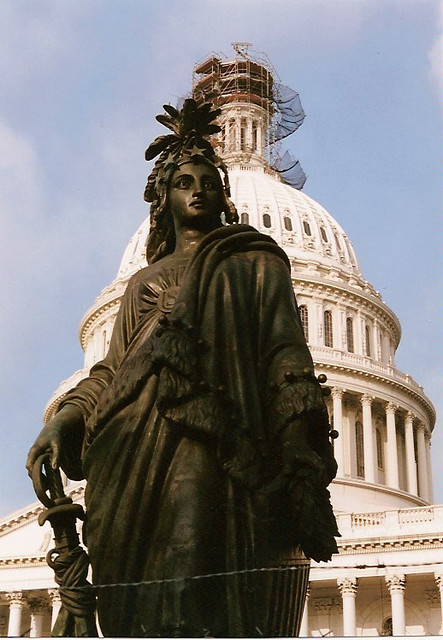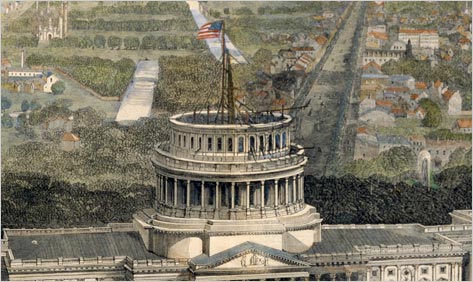
From the Washington Post, "Slave named Philip Reid helped create Statue of Freedom that sits atop Capitol," by Guy Gugliotta, on 11 April 2012 -- Emancipation Day in the District of Columbia, in 1862, found Philip Reid working in a Bladensburg foundry, helping to cast a giant bronze statue destined to crown the massive new dome of the U.S. Capitol building.
He was a slave, owned by the foundry’s owner, Clark Mills, and the statue he was working on was a symbol of freedom. He is the only slave known to have participated in the gigantic project, the so-called Capitol Extension that, between 1850 and 1865, added new Senate and House wings and a cast-iron dome. The addition would transform the too-small Capitol of antebellum Washington into the majestic seat of government we know today.

Construction of the Capitol Extension, topped with its symbol of freedom, was intimately and often ironically intertwined with the issue of slavery. When construction began at mid-century, then-Sen. Jefferson Davis of Mississippi, who had coaxed a $100,000 appropriation through Congress to finance the project, owned nearly 100 slaves. The extension’s architect, Thomas U. Walter, was a Southern sympathizer who once told a friend that slavery “was no sin.” Army Corps of Engineers Capt. Montgomery C. Meigs, who built the extension, was anti-slavery, but never said so publicly.
These three men took turns leading the project for 15 years, and although there is no evidence that they hired anyone but free white men, it is possible that their contractors, who provided everything from teamsters to bricks and mortar, may have used slaves.

If so, nobody thought to remark upon it. It was not until the very end of the project, during the soul-sapping depths of the Civil War, that white Northerners began to realize that black people had names and stories to tell.
Today, the Architect of the Capitol Web site includes an article about the statue, currently shrouded by scaffolding, that details the work of Walter, Mills and sculptor Thomas Crawford. Reid is not mentioned.

The events that brought Reid, a man in his 30s, to the Capitol began in 1854, when Walter designed a cast-iron dome to replace the ugly copper-sheathed fire hazard that preceded it. Walter showed his sketch to Meigs, who asked Crawford, then living in Rome, to design a statue to stand atop the dome.
Crawford mailed Meigs the photograph of a female figure that both he and Davis thought was perfect. Meigs asked Crawford to put the figure on a pedestal, so she would not stand directly atop the dome.

Crawford’s second design
Crawford’s second design was exquisite, Meigs wrote in his diary, an elegantly draped “light and beautiful figure.” She was, however, completely different from the first Freedom. She had a pedestal, but she also wore a floppy felt “liberty cap,” the symbol from classical antiquity of a manumitted slave.
Davis, overseeing the project as Secretary of War for President Franklin Pierce, did not like liberty caps. They had little meaning in the United States, he had told Meigs: “He says it is the sign of a freedman,” Meigs wrote in his diary, “and that we were always free, not freedmen, not slaves just released.”
If Meigs agreed with this bit of oblique sophistry, he left no record of it. Nor did he comment on what could become afar more incendiary problem: the irony of using a freed slave as the symbol of liberty in a nation that was holding 4 million people in bondage.
He sent the design back to Crawford, relaying Davis’s views.
A third Freedom soon appeared in mid-1856. This one was 191 / 2 feet tall — two feet taller than the others — and would weigh 71 / 2 tons when cast in bronze. The statue, Crawford wrote, was “suggested by the costume of our Indian tribes,” but it looked more like a Roman goddess with a fringed skirt. Instead of a liberty cap, she wore a crest of feathers and a bird’s head, purporting to be that of an eagle. It looked like a rooster with its mouth open.
But Davis liked it.
Ready to be cast
Three years elapsed before the plaster model of the third Freedom, shipped in six pieces, arrived at Georgetown Harbor in mid-1859 after nearly being lost at sea. Meigs uncrated the model and put it together in the old House chamber, now known as Statuary Hall, so tourists could get a look at her while American foundries lobbied for the casting job.
Mills, owner of the Bladensburg factory, won. He was no amateur. His equestrian statue of Andrew Jackson in Lafayette Square was the first bronze statue cast in the United States. And Mills considered his slave, Reid, “smart in mind” and, as he later wrote, “a good workman in a foundry.”

Casting began in June 1860, five months before Abraham Lincoln won the presidential election. There was little urgency at first. Contemporary accounts describe several instances when either the plaster model or the completed bronze Freedom had to be assembled or disassembled for transport.
The model was taken apart before it was sent in pieces to Bladensburg and the bronze pieces were bolted as each component was cast. The final product was then taken apart, and the individual pieces put into separate wagons, taken to the Capitol’s East Front lawn and put back together for public display.
By that time — the summer of 1862 — Emancipation Day had already come and gone in the District. Whether Reid was freed by then is not known, for while the foundry was just inside the District at Bladensburg, Mills — and Reid — could have lived in Maryland, still a slave state.
Assembling the statue
At some point during this long sequence of putting statues together and taking them apart, Reid stepped forward after an Italian worker, believing that he was the only person available who could do the job, refused to handle the statue unless his wages were increased. According to the New York Tribune of Dec. 10, 1863, Reid intervened, volunteering to assemble the statue when it was first bolted together for display on the Capitol lawn. This would have occurred in mid-1862.
Five years later, the writer S.D. Wyeth, in a multivolume memoir/tourist guide entitled “The Federal City; or, Ins and Abouts of Washington,” cited Mills’s son as saying that Reid had played an earlier role, that he took the plaster model apart, presumably when it was being removed from the old House chamber and taken to the Mills foundry for casting. Reid used a block and tackle, and inserted a hook in the iron eye at the top of the statue; “the rope was gently strained repeatedly” until the statue began to pull apart, Wyeth said, and Reid and Mills were able to unbolt the individual pieces. This would have occurred in mid-1860, before the war started.

In either case, it is noteworthy that both the Tribune in 1863 and Wyeth five years later thought Reid’s story important and interesting enough to relate to white readers. Before the war, references to individual black people, either free or slave, by anyone connected to the Capitol Extension project were virtually nonexistent.
But the attitudes of some had changed by Emancipation Day, and feelings ran white-hot. Walter, the onetime Southern apologist, had abandoned complacency, and when his second son wrote a letter informing him that he had joined the Confederate army, Walter’s reply was swift and savage:
“Pandemonium has been let loose upon us, but Mr. Lincoln, and his constitutional advisers have met the hydra-headed monster, and fall it must,” Walter wrote. “There can be no secession in this country. The traitors must be swept out with the broom of destruction.” It would be better to make the “South a desert than let a single traitor live to sow his pestiferous seeds abroad in the land.”

On Dec. 2, 1863, the head of Freedom was hoisted 288 feet into the air and bolted into place. Thousands showed up to stand in the late autumn chill amid derelict chunks of cast-iron, marble boulders and piles of trash.
It is not known whether Philip Reid was among them.
[Gugliotta, a former Washington Post reporter, is the author of the newly published “Freedom’s Cap: The United States Capitol and the Coming of the Civil War.” (source: © The Washington Post Company)]

From the New York Times Nonfiction Chronicle, "‘Freedom’s Cap,’ by Guy Gugliotta," by Abigail Meisel, on 21 September 2012 -- In the years before the Civil War, the United States Capitol underwent a vast expansion and refurbishing, rising anew as the Union was crumbling. This renovation transformed a “cramped, crowded, hard-used . . . building into a magisterial seat of government,” Gugliotta observes in his meticulously detailed history. He puts a human face on the project by centering the narrative on two principal (and quarrelsome) characters: the architect Thomas U. Walter and Capt. Montgomery C. Meigs, the lead engineer.

With every improvement — gleaming marble wings for the Senate and the House of Representatives; luminous frescoes for the Senate corridors; the magnificent central dome with its 19-foot bronze statue, “Freedom Triumphant in War and Peace” — arguments escalated between Walter and Meigs and among members of Congress, then debating the institution of slavery. Ironies abound. Early on, Jefferson Davis championed the expansion as providing a place for “government emblematic of its greatness” and shielded the project and his protégé, Meigs, from political interference before quitting his federal post to lead the Confederacy. The original headgear of “Freedom,” a cap symbolizing emancipation from slavery in classical antiquity, offended Davis, whose displeasure was relayed to the sculptor. The cap was eventually replaced with an eagle headdress. (source: The New York Times)

With every improvement — gleaming marble wings for the Senate and the House of Representatives; luminous frescoes for the Senate corridors; the magnificent central dome with its 19-foot bronze statue, “Freedom Triumphant in War and Peace” — arguments escalated between Walter and Meigs and among members of Congress, then debating the institution of slavery. Ironies abound. Early on, Jefferson Davis championed the expansion as providing a place for “government emblematic of its greatness” and shielded the project and his protégé, Meigs, from political interference before quitting his federal post to lead the Confederacy. The original headgear of “Freedom,” a cap symbolizing emancipation from slavery in classical antiquity, offended Davis, whose displeasure was relayed to the sculptor. The cap was eventually replaced with an eagle headdress. (source: The New York Times)





No comments:
Post a Comment